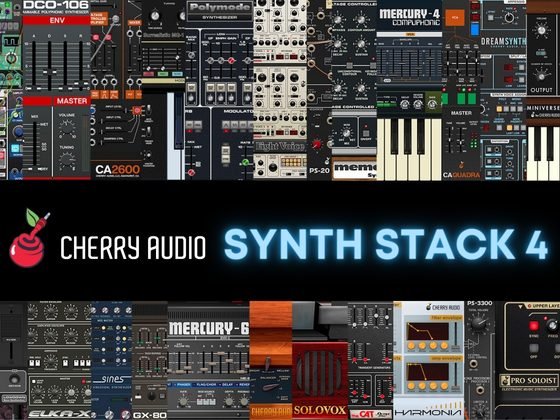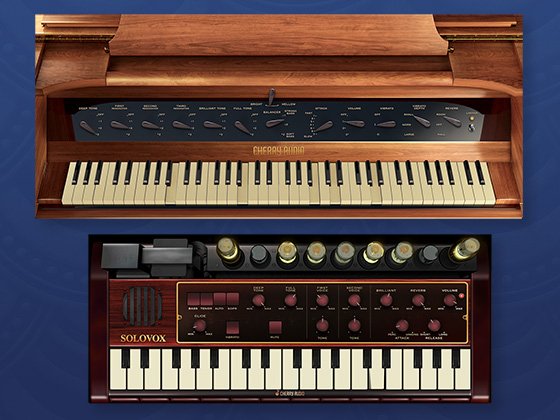Manufacturer: Benard
$20.00
This sequencer provides four independent 16-step tracks of CV and triggers, which can be used for chord progressions or counterpoint, or to control several parameters of a patch at once with related sequences. The tracks can also be combined into a single 64-step track for long sequences.
Each track has its own controls, including its own clock source, clock divider, glide time, CV offset, and play mode. Tracks can also have their own number of steps, and the first and last steps can be chosen with the respective knobs.
There are also buttons to randomize values of gates and CV knobs, reset tracks, copy and paste CV and trigger values between tracks, and to quickly set all the triggers to on or off and the CV knobs to the top or bottom of their range.
CV values can be displayed as voltage values or as octave number and pitch class name, by activating the Pitch toggle on the left. Notes can be input as voltage or octave and pitch class at any time. Additionally, there is a keyboard input mode which allows you to set the CV value of each step simply by playing notes on a MIDI or virtual keyboard, and gates can be turned on or off with a keyboard as well by sending voltages below (off) or above (on) one volt.
This module also has poly outputs, which send the outputs of the 4 tracks to the first four voices of a poly signal (in 64-step mode all four voices will receive the single 64-step sequence). You can use the expander module to combine multiple instances of the sequencer and merge their outputs into a single poly signal. This makes it possible to combine 4 instances of the sequencer, which could be sharing a clock, to produce a single 16-voice polyphonic signal with independent but related sequences of values.
Documentation
-Rate Knob - This knob sets the rate of the internal clock, and its value in BPM will be displayed in the text box above it.
-Gate Length Knob - This knobs controls the pulse width of the internal clock.
-Pitch - This toggle selects the display mode of the tooltips for the CV knobs, between voltage and pitch values.
-4 X 16 - This toggle sets the mode of the sequencer to 4X16 mode, where each of the four tracks will be independent.
-1 X 64 - This toggle sets the mode of the sequencer to 1X64 mode, where all the tracks will be merged into a single 64 step track. When this is the case, the controls of the first track will apply to all of them (and the respective inactive controls for the other tracks will become transparent).
-Stop Button - This button stops the sequencer. You can also activate it by sending a trigger to the input below it.
-Play Button - This button run the sequencer. You can also activate it by sending a trigger to the input below it.
-Track Play Toggles - These toggles will turn the respective tracks on and off. This allows you to pause certain tracks individually while others are still playing. You can also activate it by sending a trigger to the inputs below them.
-Clock Source Toggles - These toggles let you select the clock source for each of the tracks. The first track can be set to external (using the signal connected to the jack to its right) or internal. The other tracks have the same options, plus the option to pass the clock source of the previous track. This gives you a great deal of flexibility for sharing clock sources, or changing them on the fly.
-Clock Ins - Connect the external clock sources to these inputs.
-Clock Divider Knobs - These knobs set the clock division for each track.
-Glide Knobs - These knobs set the glide time for CV values of each track.
-Tack Step CV Knobs - These knobs set the CV values for each step of the respective track. When entering a new value, you can enter voltage values, or you can enter note values directly by writing the octave value followed by the pitch class. This will work regardless of the state of the Pitch toggle. The value ranges of these knobs are affected by the global range toggles, so keep in mind that if you enter a value beyond the range, it will be clipped to the highest note or voltage value in that range.
-Track Step Toggles - These toggles set the triggers on or off for each step for the respective track.
-First Step Knobs - These knobs determine the first step in the sequence for the respective tracks. When in 1X64 mode, the visible First Step Knob will set the first step for the 64-step sequence.
-Last Step Knobs - These knobs determine the last step in the sequence for the respective tracks. When in 1X64 mode, the visible Last Step Knob will set the last step for the 64-step sequence.
-Direction Toggles - These toggles determine the play direction for the respective tracks between forward, reverse, pendulum, random, and freeze. When freeze mode is selected, you can advance steps with the right and left arrows next to the freeze toggle. When in 1X64 mode, the visible Direction Toggles will set the play direction for the 64-step sequence.
-Trigger Outs - These outputs send the trigger signal for the respective track. When in 1X64 mode, the triggers of the entire sequence will go to each of the track trigger outputs.
-CV Outs - These outputs send the CV signal for the respective track. When in 1X64 mode, the CV values of the entire sequence will go to each of the track CV outputs.
-Offset Knobs - These knobs let you offset the CV values of the respective track. This can be useful for creating parallel sequences, for example with one track doubling another one an octave higher.
-Offset Inputs - These inputs let you offset the CV values of the respective track with a CV signal. The CV value of the signal will be added to the value of the CV offset knobs. It can be useful for using one track to transpose another (with a different clock subdivision), for example to create arpeggiating sequences.
-Quantized Outs - These outputs send the CV signal for the respective track, but quantized to equal temperament semitones. When in 1X64 mode, the CV values of the entire sequence will go to each of the track CV outputs.
-End of Lane Outs - These outputs will send a trigger when the respective lane reaches its end. The trigger will actually be sent out when the sequence moves to the first step again. This makes it possible to use a sequential switch to alternate between tracks, if you want to combine for example 2 or 3 of the individual tracks, or even have different combinations going to different destinations. Connect the sequences to the different steps of the switch, and use the EofL trigger of one of the tracks to advance the switch. When in 1X64 mode, the EofL outs will send a trigger whenever the respective layer of the sequence has ended.
-Copy and Paste Buttons - These buttons allow you to copy the trigger or CV values of a track (CT for copy triggers, CK for copy knobs) and paste them to another track (PT for paste triggers, PK for paste knobs). This is useful to duplicate sequences easily.
-All Steps Buttons - These buttons allow you to set the values of all the step trigger toggles or CV knobs of a track at once to on or off for toggles, and to 0 or 1 for knobs.
-Randomize Buttons - These buttons allow you to set the values of all the CV knobs of a track at once to individual random values, or the step toggle values randomly to on or off. You can also trigger this with CV using the trigger inputs to the right.
-Track Reset Buttons - These buttons allow you to reset each track individually to the first step in the active play mode. You can also trigger this with CV using the trigger inputs to the right.
-Global Reset Button - This buttons allows you to reset all the tracks at once to the first step in the respective active play mode. You can also trigger this with CV using the trigger inputs to the right.
-Global Randomize Buttons - This buttons allows you to set the values of all the CV knobs of all the tracks at once to individual random values, or the step toggle values of all the tracks randomly to on or off. You can also trigger this with CV using the trigger inputs to the right.
-Poly Outputs - These outputs pack the signals from the 4 individual tracks into a single poly signal. They can then be combined using the expander module, for cases when you need more than 4 voices. In 1X64 mode, the entire sequence will go to each one of the voices.
-Range Toggles - These toggles set the global voltage range for all the CV knobs.
-Clock Out - This jack outputs the internal clock signal so that you can use it to clock other modules.
Input Section
-On Toggle - This toggle allows you to enter input mode, where you can set the values of the knobs and toggles for each track using a keyboard. When this mode is engaged, track LEDs will appear on the left to show you the active track. The sequencer will also automatically switch to 4X16 mode.
-Trig / CV Switch - This switch selects the input signal destination, to set trigger and CV values.
-Track Toggles - These toggles select the track that is active for input. The green track LEDs on the left will update to reflect the active track.
-Gate In - Connect the gate signal of the top VM panel to this input.
-CV In - Connect the Pitch signal of the top VM panel to this input.
When you play notes on a keyboard, the gate will advance the step. When in CV mode the pitch value will set the value for the knob at that step. When trig mode is selected, values above 1V will set the toggle for that step on, and values below 1V will set them to off. When the end of the track is reached, it will loop back to the beginning, and start setting the values for those steps again.



























































